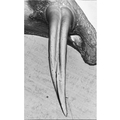The biophysics of snakebites:
Poisonous tears
16.05.2011, Press releases
Snakes inject venom into their victims bodies using hollow poison fangs – or so most people believe. However, fact is that most snakes and many other poisonous reptiles have no hollow fangs. Physicists at the Technische Universitaet Muenchen (TUM) have now uncovered the tricks these animals use to force their venom under the skin of their victims.
For years Professor Leo von Hemmen, a biophysicist at the TU Muenchen, and Professor Bruce Young, a biologist at the University of Massachusetts Lowell, have been researching the sense of hearing in snakes. While discussing the toxicity of their snakes, it dawned on them that only few snakes inject their venom into their victims’ bodies using hollow poison fangs. Yet, even though the vast majority of poisonous reptiles lack hollow fangs, they are effective predators.
Only around one seventh of all poisonous snakes, like the rattlesnake, rely on the trick with the hollow poison fang. The vast majority has developed another system. A typical representative of this class is the mangrove pit viper, Boiga dendrophila. Using its twin fangs, it punches holes into the skin of its victims. The venom flows into the wound between the teeth and the tissue. But there is an even easier way: many poison fangs simply have a groove the venom flows along to enter the wound.
The researchers asked themselves how this simple method could be so successful from an evolutionary perspective, considering that bird feathers, for example, should be able to easily brush away any venom flowing along an open groove. To get to the bottom of this mystery, they investigated the surface tension and viscosity of various snake venoms. The measurements showed that snake venom is amazingly viscous.
The surface tension is high, about the same as that of water. As a result, the surface energy pulls the drops into the fang grooves, where they then spread out. In the course of evolution, snakes have adapted to their respective preferred prey using a combination of optimal fang groove geometry and venom viscosity. Snakes that prey on birds developed deeper grooves to keep the viscous venom from being brushed away by bird feathers.
The researchers also found an answer to the question of how snakes manage to ferry the venom well under the skin of their prey. After all, only there can it unfold its deadly effect. Here too, snakes developed a trick in the course of evolution: When a snake attacks, the fang grooves and the surrounding tissue form a canal. Just like blotting paper, the tissue sucks the venom through this canal. And snake venom has a very special property to facilitate this effect: Just like ketchup, which becomes significantly more fluid upon shaking, the sheer forces that arise from the suction cause the venom to become less viscous, allowing it to flow through the canal quickly as a result of the surface tension.
Scientists refer to substances with these characteristics as non-Newtonian fluids. These have a very practical consequence for snakes: As long as there is no prey in sight, the venom in the groove remains viscous and sticky. When the snake strikes, the poisonous “tears” flow along the groove – just like wine along a glass – and into the wound, where the venom takes its lethal effect.
The German Federal Ministry for Education and Research funded portions of this work via the Bernstein Center for Computational Neuroscience Munich. Professor van Hemmen is a member of the Excellence Cluster Cognition for Technical Systems (CoTeSys).
Original publication:
Tears of Venom: Hydrodynamics of Reptilian Envenomation Bruce A. Young, Florian Herzog, Paul Friedel, Sebastian Rammensee, Andreas Bausch und J. Leo van Hemmen, Physical Review Letters, 106, 198103 (2011) DOI: 10.1103/PhysRevLett.106.198103
Previous publication:
Auditory localization of ground-borne vibrations in snakes
Paul Friedel, Bruce A. Young, und J. Leo van Hemmen
Physical Review Letters 100, 048701 (2008) –doi: 10.1103/PhysRevLett.100.048701
Link: http://portal.mytum.de/pressestelle/pressemitteilungen/news_article.2008-01-30.2480323170
Contact:
Prof. Dr. J. Leo van HemmenTechnische Universitaet Muenchen
Chair of Theoretical Biophysics (T35)
85747 Garching, Germany
Tel.: +49 89 289 12380 – Fax: +49 89 289 12296
E-mail – Internet
Kontakt: presse@tum.de
More Information
| 110503_VenomFlow_PW_DE.pdf |
Druckversion der Presseinformation (DE),
(Type: application/x-pdf,
Size: 113.9 kB)
Save attachment
|
|
| 110503_VenomFlow_PW_EN.pdf |
Printable version of the press release (EN),
(Type: application/x-pdf,
Size: 99.0 kB)
Save attachment
|




